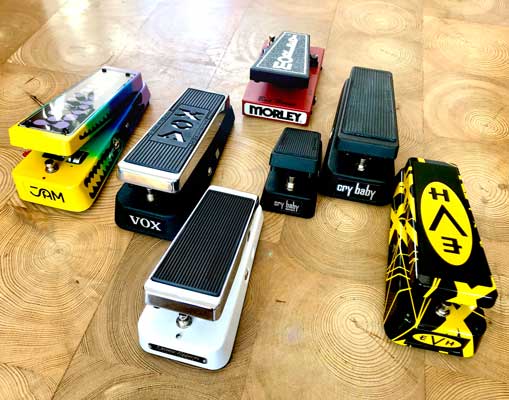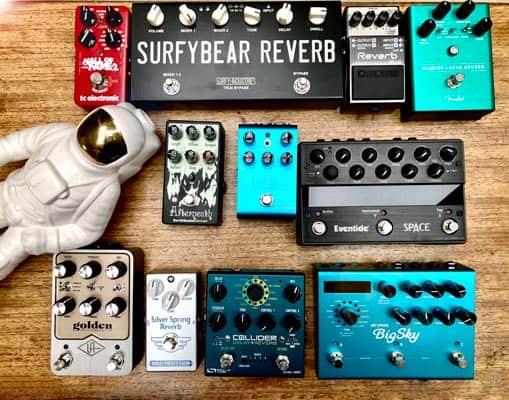Comparison Chart: Best Compressor Pedal
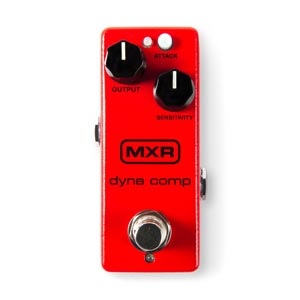
Check Price:
Pros
- The Pedal for authentic 70’s squash, Funk, or Chicken Pickin’
- Great Price
- Mini Size
- All Analog Signal Path
- Couldn’t be simpler
Cons
- Not transparent
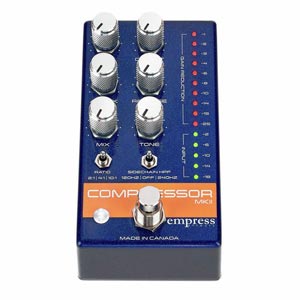
Check Price:
Pros
- Our favorite pedal for transparent, ‘always on’ compression
- Excellent for clean guitar and acoustic instruments
- All Analog Signal Path
- Separate Gain Reduction and Input Metering on the Pedal for precise control
Cons
- It won’t give you dirty artifacts or a Dyna Comp squash
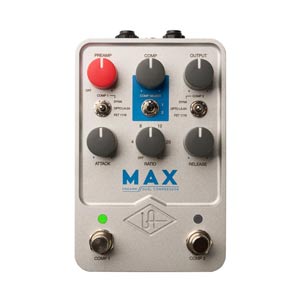
Check Price:
Pros
- Dual compressor and Preamp all-in-one
- Fantastic UA610 Preamp Emulation
- Something for everyone: transparency, sustain, squash, harmonically rich, dirty grit, jangle…
- High-end emulations of vintage compressors including the LA-2A, 1176, and Dyna Comp.
- Bluetooth and USB-C connectivity
Cons
- No Mix knob to blend the dry and wet signals
- DSP emulations, not for analog purists
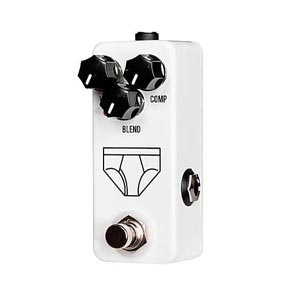
Check Price:
Pros
- Great ‘always on’ compressor
- Blend knob allows a subtle dry/wet mix
- Great Price
- All Analog Signal Path
- Also great a providing snap and even squash
Cons
- There are better options (Empress Effects MKII) for acoustic guitar
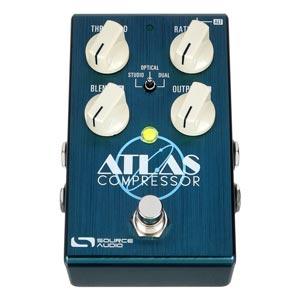
Check Price:
Pros
- Do-it-all compressor with high quality emulations of classic compressors
- Ability to stack two compressors
- Doubles as a Bass Compressor
- Something for everyone: transparency, sustain, squash, harmonically rich, dirty grit, jangle…
- Competitive Price
Cons
- Controls could be more user-friendly
- App connection requires Mini-USB connection, no Bluetooth option
- DSP emulations, not for analog purist
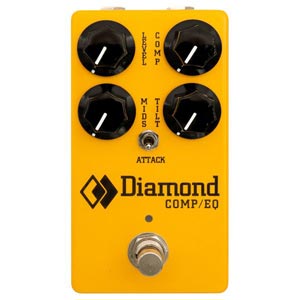
Check Price:
Pros
- The most touch-sensitive, musically responsive pedal on this list
- Tilt EQ for extra cut
- Pleasing dirty artifacts in the heavy compression
- All Analog Signal Path
Cons
- Not ideal for acoustic guitar
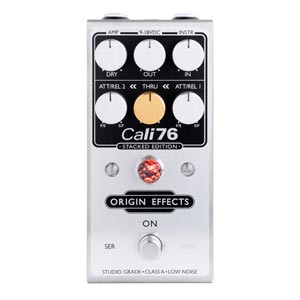
Check Price:
Pros
- Dual FET Compressors and Preamp in pedal format
- All Analog Signal Path
- Ability to stack two compressors, each with independent controls
- Very responsive to playing
Cons
- Might not appeal to guitarists who want drastic change in the envelope of their sound.
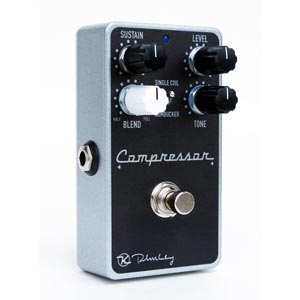
Check Price:
Pros
- Excellent for 70s squash, Funk, Chicken Pickin’
- Our favorite Dyna Comp imitator
- Blend Knob offers more transparency
- All Analog Signal Path
Cons
- Some prefer the envelope-changing sound of the original Dyna Comp
Why Do I Need A Compressor Pedal?
The compressor pedal, often overlooked by beginner guitarists, is perhaps the most powerful tool in a pedalboard. In reference to their compressor pedals, guitarists often use words like ‘indispensable’ or ‘secret sauce’. The results of a compressor pedal are not always obvious, but when used in the right way, it can do a lot of things for your guitar playing.
Here are a few things a compressor pedal can do for you:
- Be Your Dynamic Glue – A compressor pedal smooths out the intensity and volume peaks that naturally happen when you are switching between rhythm and lead or between fingerpicking and strumming. It can turn a collection of sounds from your looper into one cohesive sound.
- Boost Clean Tone – Clean guitar can often get lost in the mix of a band. A compressor pedal can amplify your signal and get you heard.
- Bring out Acoustic Guitar, Steel, and Nylon strings – Acoustic guitar when amplified can sometimes sound like a lesser version of itself, especially classical guitar and other instruments with nylon strings. A compressor can bring your acoustic sound to life in a stage mix.
- Increase Sustain on Lead – Lead guitar benefits greatly from a compressor pedal as it helps you achieve consistent sustain without distortion, loss of articulation, or adding volume.
- Clean Up Your Picking – You might wonder how some guitarists sound so smooth when picking. Yes, good technique is the main culprit, but you can also bet they are using a compressor pedal. A compressor pedal will even out the spikes in your picking.
- Thicken and Warm Up Your Overall Tone – A compressor can be used to sculpt the weight and warmth of your sound.
- Clean Up Your Bass – Many bassists won’t play without their compressor pedal of choice. In addition to bringing out the lowest bass notes and overall articulation, a compressor pedal can clean up finger noise, add sustain, and even make bass easier to play.
We recommend placing a compressor at the beginning of your signal chain. A good starting point is: Compressor – Wah – Drive – Fuzz – Modulation – Delay – Reverb. For more on how compressor pedals work, see our post What does a Compressor Do?
How We Chose the Best Compressor Pedals
For this buyer’s guide, we shortlisted 8 of the most popular and most highly recommended compressor pedals out there. These pedals cover a wide range of compressor needs, from squash and sustain to subtle, ‘always on’ compression.
We tested all 8 pedals side-by-side to see how they compare and to see if they are worth the money. See here for all of our guitar equipment reviews and audio knowledge and gear reviews.
More on Guitar Pedals…
Classic
MXR Dyna Comp Mini
our rating
4.9
Check Price:
Bottom Line:
The Classic 70’s squash compressor. If this is your sound, look no further.
Ideal User of the MXR Dyna Comp Mini
Guitarists and musicians looking for an affordable, squishy, less transparent compressor pedal.
Pros
- The Pedal for authentic 70’s squash, Funk, or Chicken Pickin’
- Great Price
- Mini Size
- All Analog Signal Path
- Couldn’t be simpler
Cons
- Not transparent
Our Take
First released in 1972, the MXR Dyna Comp is a legendary compressor pedal with a simple circuit that uses OTA compression. The also-famous Ross Compressor followed soon after emulating the circuit of the Dyna Comp.
Many other excellent imitators came thereafter including the Keeley Compressor Plus, Wampler Ego, and the Xotic SP, to name a few…
The MXR Dyna Comp Mini has a button for two attack/release options, one fast, and one slow. Either way, the pedal was never designed to be transparent. That said, it still does a nice gentle compression. You can hear this below in the example from our tests:
Compared to its circuit imitators (like the Keeley Compressor Plus), it just drives a bit harder and changes the sound a little more.
For the classic Dyna Comp sound with heavier compression, the percussive pop of the transient is leveled off with a Dyna Comp, and the bass and treble are rolled off slightly, bringing out and thickening the mids. In the example below, we use heavy compression to the point of limiting:
This compressor became the go-to for country chicken pickin’, funk rhythm, and slide guitar almost as soon as it came out. Here’s our Chicken Pickin’ example below:
Used by David Gilmour for sustain, David Summers for squish, slide players like Lowell George and Sonny Landreth, and countless others, the simplicity of the MXR Dyna Comp continues to appeal.
There are loads of variants including the Dyna Comp Bass and the Dyna Comp Plus which includes a handy ‘Clean’ knob for mixing in the dry signal. We like the Mini for its size, simplicity, and two attack/release options.
In our opinion, it’s still one of the best pedals out there for guitarists who want to sustain and squash their sound in a pleasing way. The pedal couldn’t be simpler. We love it.
Best for Transparency
Empress Effects Compressor MKII
our rating
4.9
Check Price:
Bottom Line:
Our favorite for high-end, transparent compression. Great for clean electric and acoustic guitar.
Ideal User of the Empress Effects Compressor MKII
Guitarists and musicians looking for high-end, transparent, ‘always on’ compression in a pedal.
Pros
- Great pedal for transparent, ‘always on’ compression
- Excellent for clean guitar and acoustic instruments
- All Analog Signal Path
- Separate Gain Reduction and Input Metering on the Pedal for precise control
- Easy to use
Cons
- It won’t give you dirty artifacts or a Dyna Comp squash
Our Take
First released in 2011, the Empress Effects Compressor MKII is an all-analog pedal that has all the advanced compression features that you find on studio rack units such as input and gain reduction metering, independent attack and release controls, a mix knob for parallel compression, and an external sidechain insert.
The Empress Effects Compressor MKII is standard pedal size (12cm X 6.5cm) and still manages to pack in a 12-LED gain reduction meter and a 6-LED input meter. The metering really changes the game in terms of precision.
The Compressor MKII is our favorite for transparent ‘always on’ compression. I loved it for clean electric guitar picking, steel-string, or nylon-string acoustic guitar. The all-analog signal retains the sound of the instrument while adding lift and clarity.
The pedal circuit also includes a ‘color circuit’ which adds a pleasing harmonic distortion without compression.
In the examples below, you can hear the results yourself:
For electric guitar, the pedal is capable of squashing the sound for lead sustain while retaining the tone of your guitar. The tilt-style EQ knob will also help guitar cut in any mix. If you’re looking for the kind of dirty artifacts that a Dyna Comp or Diamond will give you, however, this is probably not your pedal of choice.
For an equally transparent bass experience, the Empress Effects Bass Compressor is the bass version of this pedal.
Does-it-all
UAFX Max Preamp & Dual Compressor
our rating
4.8
Check Price:
Bottom Line:
Dual compressor with a great preamp all-in-one. Excellent pedal that offers wide range of creative possibilities.
Ideal User of the UAFX Preamp and Dual Compressor Pedal
Musicians who want a high-quality compressor pedal that offers a wide range of compression possibilities
Pros
- Dual compressor and Preamp all-in-one
- Fantastic UA610 Preamp
- The ability to stack the compressors offers a lot of creative flexibility
- High-end emulations of vintage compressors including the LA-2A, 1176, and Dyna Comp.
- Bluetooth and USB-C connectivity
Cons
- No Mix Knob to blend the dry and wet signals
- DSP emulations, not for analog purists
Our Take
The Universal Audio Max Preamp and Dual Compressor packs a lot into one pedal. Using high-end digital emulations of classic compressors rather than analog circuitry, this pedal could convert analog purists to the DSP dark side.
In practice, it’s very straightforward to use. With two foot switches, 6 knobs, and three small selection switches, the controls are easily understood without the need to consult a manual.
The Max does almost anything you would want from a compressor. It can squash the envelope, hit your attacks and releases hard for mega-sustain, give you percussive funk, or saturated distortion, smooth everything out, blend parts together, or give you gentle compression (although there’s no Mix knob, more on that later…)
We liked the UAFX Max compressor pedal’s ability to give you a lot of different colors. The pedal has three high-quality emulations of classic compressors: the Teletronix LA-2A, the UREI 1176, and the Dyna Comp. These are essentially Universal Audio’s coveted plugin emulations in pedal form.
Used individually, LA-2A gives you slow, transparent compression, the 1176 quick, clean response, and the Dyna Comp can give you a lo-fi overdrive. Stacked, the options really open up. Layered compression produces the best, most natural-sounding compression and it also can give you fantastic drive effects.
For example, stacking an 1176 on the LA-2A has the advantage of both a smoother transient and a smoother decay, because the 1176 is so fast and the LA-2A slow. Or set the pedal up with dual 1176 compression (one driving the other into distortion) and you have the classic Led Zep, Jimmy Page sound instantly.
We also liked the preamp options. The UAFX Max comes with a UA 610 Tube Mic Preamp emulation. If you’re familiar with the UA 610 analog unit, or the UA 610 plugin, it’s a fantastic way to give your mix some saturated, gritty breakup as well as a subtle way to glue things together.
We liked driving the Dyna Comp hard into an 1176 for a completely changed envelope. It’s basically functioning as a drive pedal with massive sustain here in this example from our tests:
It also does gentle compression well, especially using the LA-2A style emulations. It doesn’t really change the sound, but just adds a little lift and sparkle. You can hear it below in our example:
That said, the biggest downside of this pedal is its lack of a mix or blend knob. You have the option to blend the two compressors in a myriad of ways, and a helpful ‘All’ setting on the Ratio which allows you to include the coloration of the compressor without any compression applied to the sound. But surprisingly, there is no option to mix the dry signal with the compressed signal. You can achieve subtle compression with this pedal, but not in the standard dry/wet mix way.
The UAFX Max is a modern pedal in terms of connectivity. There is a USB-C connection on the back and the UAFX App pairs via Bluetooth. This gives you access to additional controls, including the ability to run parallel compression as a mix on the output or send them as dual mono signals.
If you aren’t interested in stacking compressors or simply want a simpler compressor pedal, UA offers cheaper single-unit versions of these compressors: the UAFX 1176 and the UAFX LA-2A. (Both of which have a mix knob)
On the whole, we really liked this pedal. It costs less than the all-analog Origin Effects Cali76 Stacked and it offers more creative options. It lacks a mix knob and it is slightly less touch-sensitive than all-analog pedals, but the sound is fantastic.
JHS Whitey Tighty
our rating
4.7
Check Price:
Bottom Line:
Excellent ‘always on’ Mini compressor for E Guitar life and snap.
Ideal User of the JHS Whitey Tighty
Guitarists and musicians looking for Mini compressor pedal that doesn’t sound like a Dyna Comp
Pros
- Great ‘always on’ compressor
- Blend knob allows a subtle dry/wet mix
- Great Price
- All Analog Signal Path
- Also great a providing snap and even squash
Cons
- There are better options (Empress Effects MKII) for acoustic guitar
Our Take
The Whitey Tighty is a relatively new compressor pedal from JHS. It’s a mini-FET compressor pedal with three knobs. It gives an 1176-style subtle distortion when jacked up, or a quick, subtle compression on lower settings.
It excels as an ‘always on’ compressor, giving a bit of sparkle and lift to your playing without sounding too ‘compressory’. This is clear in the example below from our tests:
That said, I really liked the drive of this little guy. With compression jacked, the Chicken Pickin’ sound is fantastic and it gives a hint of crunch when used as limiter. You can hear both examples below:
We love the size of it (1 X 3 inches), the blend knob, and its overall simplicity. If you’re looking for a simple, small compression pedal that doesn’t sound like an MXR Dyna Comp/Ross Compressor, look no further.
Does-it-all
Source Audio Atlas Compressor
our rating
4.6
Check Price:
Bottom Line:
A compressor that does it all: Guitar, Bass, Acoustic, Studio.
Ideal User of the Source Audio Atlas Compressor
Guitarists and musicians looking for compressor that does everything: Guitar, Bass, Studio
Pros
- Do-it-all compressor with high quality digital emulations of classic compressors
- Ability to stack two compressors
- Doubles as a Bass Compressor
- Something for everyone: transparency, sustain, squash, harmonically rich, dirty grit, jangle
- Competitive Price
Cons
- Controls could be more user-friendly
- App connection requires Mini-USB connection, no Bluetooth option
- DSP emulations, not for analog purists
Our Take
The Source Audio Atlas Compressor is a do-it-all digital compressor pedal that can be used for guitar, bass, or any instrument that can use a pedal. It can even double as a studio compressor.
The technical specs of this pedal are impressive: the AD/DA conversion is 24-bit, the digital path is 56-bit, and the dynamic range is 110 dB. It comes loaded with two compressors that can be configured in series or parallel. The ‘Band Split’ provides the option to compress high and low frequencies differently.
As well as manual control of the onboard controls (WYSIWYG mode in the hardware options), there is a preset mode that nicely simplifies the advanced pedal. This gives you six factory presets that cover a wide range of compression needs.
The presets include: Studio Snap (aggressive, hard-knee, VCA-style compression that results in a snappier, more rhythmic sound); Opto Rack (LA-2A-like compression that is smooth, forgiving, and slow); Dual Band (splits frequencies at 333 Hz and compresses the lows and highs separately for a cleaner, more resonant sound); Studio 76 (emulates the fast attack of an 1176); Cubic Zirconia (LED Opto-style compression that emulates the fast release and dirty artifacts of a Diamond Compressor); and Dual Jangle (modern compressor sound that enhances anything above 2 kHz, for 12-string and Jangly strumming.)
In other words, the compressor does everything you’d want a compressor to do.
Here’s the Studio Snap preset from our tests below:
One of the things we loved about this pedal is the ability to use it as a bass compressor without any compromises. In addition to having a lower frequency range that is compressed, bass guitar needs a much slower release and attack. Because lower frequencies travel slower, a standard compressor can follow the bass too well and distort the sound.
By holding the control button on the back of the pedal while powering up, all the presets will be optimized for bass.
On the downside, whether used for bass or guitar, the controls on the Atlas Compressor aren’t as easy to operate as I would like. Pressing the ‘Alt’ button on the back moves you into the second bank of presets (the light glows red instead of green). The ‘Alt’ button also changes the ‘Blend’ knob to ‘Attack’, and the ‘Output’ knob to Release’.
The controls are not all that difficult to work out after some fiddling, but they are not as straightforward as those of the other pedals on this list.
Nevertheless, the Atlas Compressor is significantly cheaper than the digital UAFX Max or the analog Origin Effects Cali76 Stacked, it sounds just as good, and it can double as a bass compressor. It might be overkill for some, but this is a great choice for anyone seeking high-quality digital compression options in a pedal.
Diamond Guitar Compressor EQ
our rating
4.6
Check Price:
Bottom Line:
A compressor pedal with the most touch-sensitive, musical response on this list.
Ideal User of the Diamond Guitar Compressor EQ
Guitarists looking for a musical, expressive pedal good for clean and dirty styles.
Pros
- The most touch-sensitive, musically responsive pedal on this list
- Tilt EQ for extra cut
- Pleasing dirty artifacts in the heavy compression
- All Analog Signal Path
Cons
- Not ideal for acoustic guitar
Our Take
The Diamond Guitar Compressor EQ Pedal uses an LED Optical compression circuit, unlike any of the pedals on this list. Since its release in 2005, it has become a pedalboard favorite for many guitarists and bassists. It is known for its faster release, touch-sensitive response, and the dirty sonic artifacts in its final results.
In 2023, the company restarted with 5 flagship pedals including this Comp/EQ pedal. Along with ‘Compresion’, ‘Level’, and an attack toggle switch, the latest model of this pedal has split the EQ knob on previous models into two control knobs for ‘Mids’ and ‘Tilt’. ‘Mids’ cuts or boosts the Midrange. ‘Tilt’ is a seesaw filter pivoting at 800 Hz. This knob raises the high frequencies while cutting the lows, and vice versa.
We liked the Diamond for its musical, touch-sensitive response. It’s simply a joy to play with. Its range of compression possibilities seems to be greater than a Dyna Comp and maybe a less than the dual compression options on this list.
The Diamond Guitar Compressor EQ is the most expressive and responsive compressor on this list with results that are a little bit dirty (in a good way). For electric guitar, subtle or hard, this is a fantastic compressor pedal.
Origin Effects Cali76 Stacked Edition Compressor
our rating
4.6
Check Price:
Bottom Line:
Dual all-analog 1176-style compressors and a preamp in pedal form . Responsive to playing with great sound and loads of subtle compression possibilities.
Ideal User of the Origin Effects Cali76 Stacked Edition
Guitarists and musicians looking for high-end classic reverbs in a pedal
Pros
- Ability to stack two compressors, each with independent controls
- Dual 1176-style compressors and a preamp in pedal form
- Very responsive to playing
- All Analog Signal Path
Cons
- Based on the UREI 1176, the compressors are transparent and fast. This might not appeal to guitarists who want to change the envelope of their sound.
Our Take
The Origin Effects Cali76 Stacked Edition gives you a preamp, and two 1176-style compressors offering abundant compression options. Appealing to analog purists, these are not DSP emulations, these are actual analog compressors in a pedal.
The latest version is a more slender, pedalboard-friendly size. It has ditched the full-meter LED of its too-large predecessor for a single jewel light that glows yellow, orange, and red in response to its compression.
Simon Keats, who began with Vox, is the circuit designer. Since its release, it has become quite popular on pedalboards, including those of some celebrity guitarists like David Gilmour (apparently he uses several compressors).
The UAFX Max is the digital modelling version of this pedal. They both have a preamp, which helps to drive a stronger signal into the compressor and the ability to stack the compressors, driving one into the other.
Unlike the UAFX Max, the Cali76 doesn’t really change your sound massively. Based on an 1176, it’s not meant to alter the envelope of your guitar sound. But it is more touch-sensitive, and musically responsive to play.
In the example from our tests below, we tried to drive the compression hard to alter the envelope and add distortion. We had some success, but as you can hear, it’s not anything like the squishy Dyna Comp or an Orange Squeezer.
We really liked the controls and simplicity of the knobs on the Cali76. The ‘In’ knob gives you preamp drive to hit the first compressor with. You then have loads of options with the two compressors: with separate attack/release knobs you can use the first compressor to increase sustain and the second to smooth the transients, or vice versa, or just squash everything.
The Cali76 Stacked is particularly good at adding a pleasant snap to rhythm parts like the example below from our tests:
The ‘Thru’ knob allows you to drive the first compressor into the second harder or softer, and for subtle dry/wet mix, you have the ‘Dry’ knob.
In summary, we can highly recommend this pedal. We especially liked how responsive it is to guitar playing. If you are a slide player, or you just want a lot of flexibility in your compression options, you will be happy with this pedal. Because it packs two analog compressor circuits into its small body, it is pricier than others on this list.
If you like this pedal but don’t need dual compression, the Cali76 Compact is also an excellent, more affordable, and simpler option.
Keeley Compressor Plus
our rating
4.5
Check Price:
Bottom Line:
Our favorite Dyna Comp imitator. Dyna Comp squash with more versatility.
Ideal User of the Keeley Compressor Plus
Guitarists and musicians looking for Dyna Comp style pedal with slightly more modern sound.
Pros
- Excellent for 70s squash, Funk, Chicken Pickin’
- Our favorite Dyna Comp imitator
- Blend Knob offers more transparency
- All Analog Signal Path
Cons
- Some prefer the envelope-changing sound of the original Dyna Comp
Our Take
The Keeley Compressor Plus uses a Dyna Comp-style circuit. This is our favorite of the popular Dyna Comp imitators (Ross, Xotic SP, Wampler Ego, to name a few) all of which are great at 70s-style squash.
The controls consist of four knobs (Sustain, Level, Blend, Tone) and a Single Coil/Humbucker toggle switch (essentially providing two presets for attack and release).
We liked the Keeley Compressor Plus for its Dyna Comp lo-fi grit mixed with a bit of modernity with its Blend and Tone knob. Those looking for a Dyna Comp-style pedal with flexibility will be pleased with this pedal.
How We Tested These Pedals
For our tests, we used a Fender Strat with single coil pickups and Tele with P90s. The amp is a Fender Princeton Reverb miked with an SM57. To give you the raw sound, there’s nothing else in the signal chain. We used a Universal Audio Apollo Solo Interface recorded with Logic Pro X.
Questions or Comments?
Follow the discussion here on Facebook.
